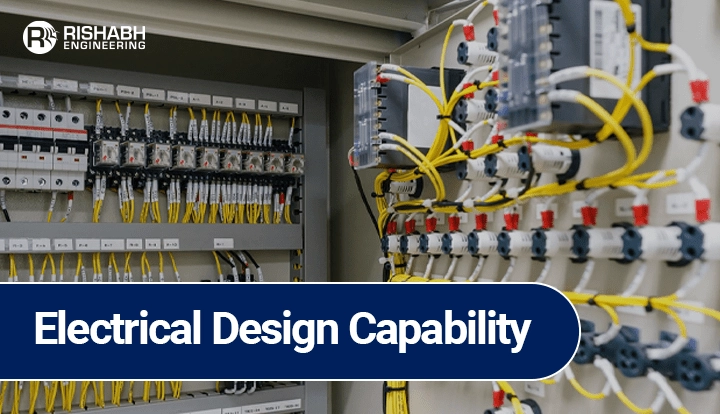
Industrial Electrical System Design Specifics
Electrical design that is well-structured is essential for both building and human safety. Design software offers a rapid way to plan and execute effective electrical installations. When done correctly, industrial electrical system design guarantees the safe running of a machine, structure, or other object. It is a challenging and serious endeavor. Despite being essential to success, electrical systems in infrastructure and industrial development cannot be disregarded. Electrical systems that are dependable and efficient are essential to modern buildings because they power everything from machinery to lighting. It’s a multi-step, intricate procedure that never ends. Before moving on to the next step, the designer can show the client the complete design package thanks to the incremental stage planning and electrical installation design.

In this article, we will cover the essentials of industrial plant electrical system design, its key components, process, and best practices along with how Rishabh Engineering can help with real-life use cases.
What Is Electrical System Design?
The process of organizing and recording the building of a power system is known as electrical system design. Everything from the initial feasibility study to the completed set of construction plans is contained in this. A well-designed electrical system is safe, simple to set up, and follows all applicable regulations. Additionally, it considers the requirements of the project.
Importance Of Electrical Systems Design
The planning, organization, and specification of electrical systems inside a specific area or facility cover all parts of the diverse field of electrical systems design. It helps ensure that the electrical system is safe and efficient, further, it meets all applicable codes and regulations. Designing of electrical systems design ensures that the system is durable, and it will stand up to the wear and tear of daily use. Specialist teams from multidisciplinary engineering companies can help design electrical systems for your commercial project that is functional, high-quality, and properly sized to fit the needs of the project.
Key Components Of Electrical System Design
The distribution of electricity, safety, and the smooth functioning of different electrical components are all handled by these systems. Factors including load distribution, voltage needs, safety regulations, and future scalability are all considered while designing an electrical system.
1. Load Analysis: It involves conducting thorough load analyses to determine the electrical requirements of a facility. This involves figuring out how much electricity certain devices and systems require to make sure the electrical infrastructure is suitable in size and able to manage the expected load without sacrificing effectiveness or security.
2. Power Distribution: Efficient power distribution is paramount in any industrial setting. It takes skill to develop complex power distribution systems that optimize the flow of energy, reduce losses, and follow industry guidelines. Their designs minimize downtime and increase ultimate productivity by ensuring a steady supply of electricity for all essential components.
3. Safety Measures: Safety is a top priority in electrical systems design, and our team is committed to implementing robust safety measures. They help implement security measures that enable in reduction of the dangers connected with electrical systems. It is achieved by conducting fault analysis and conforming to international regulations.
4. Automation and Control Systems: In the era of Industry 4.0, automation plays a pivotal role in enhancing productivity and efficiency. It helps facilitate the management and administration across a range of operations. This is possible by incorporating advanced control and automation technologies into their electrical blueprints. This lowers maintenance costs and downtime by facilitating predictive maintenance and enhancing operational management.
5. Varied Electrical Solutions: From High Tension (HT) to Low Tension (LT), encompassing MVT (24 V) and Low Voltage (LV) systems, our expertise extends to Large Low Voltage (LLV) applications, ensuring comprehensive solutions for diverse electrical systems.
- HT systems: They are designed for power distribution at voltages above 1 kV (1000 volts).
Key components: transformers for stepping up and down the voltage, circuit breakers for protection, isolators, and potential transformers for measurement - LT systems: Low Tension (LT) systems are designed for power distribution at voltages below 1 kV (1000 volts).
Key components: distribution panels, circuit breakers, fuses, contactors, and power factor correction equipment. - MVT (24 V) – Instrumentation: Medium Voltage Transformers (MVT) are used for stepping down voltage to 24 volts, especially for instrumentation and control systems.
Key components: MVT, control panels, signal conditioners, sensors, and programmable logic controllers (PLCs) for automation. - LV systems: Low Voltage (LV) systems typically refer to voltages below 1000 volts and are common in residential and commercial settings.
Key components: distribution boards, circuit breakers, wiring systems, outlets, and switches. - LLV systems: Extra consideration may be given to Low-Load Voltage (LLV) systems, which are designed for minimal power requirements or standby applications.
Key components: energy-efficient equipment, backup power sources (e.g., batteries or generators), and smart control systems to optimize energy usage.
Electrical System Design Process
- Define the Scope and objectives: The initial phase of crafting electrical systems for intricate projects involves clearly outlining the project’s scope and objectives. It would comprise determining the electrical system’s aim, function, and efficiency needs while keeping the budget, timeframe, and quality standards in mind. More so it is also important to specify the duties of users partners and beneficiaries.
- Conduct a Site Survey and Analysis: Following the scope definition, the next step in designing electrical systems for complex projects is conducting a thorough site survey and analysis. This entails physically visiting the construction site to gather pertinent data on existing infrastructure, resources, and limits. Evaluations of load distribution and demand, environmental and safety considerations, potential difficulties and hazards, and power supply availability and dependability are all included in the assessment. A knowledge of the pertinent norms, standards, and laws about the planning and construction of electrical systems is also necessary.
- Develop a Conceptual Design: Progressing from the site survey, the third step involves developing a conceptual design. This calls for creating and assessing a range of design options that are in line with the objectives and scope of the project. It is necessary to consider elements that are technological, economic, social, and environmental. To show and contrast design options, a variety of tools are used, such as models, simulations, computations, diagrams, and sketches. To make sure that users’ and beneficiaries’ wants and preferences are considered during the design process, feedback from these groups is essential.
- Prepare a Detailed Design: After conceptualization, the fourth step is preparing a detailed design. This entails selecting and documenting the design solution that best fits the goals and scope of the project. Comprehensive specifications are provided for the parts, supplies, machinery, layout, connections, wiring, controls, protection, and testing. Drawings, specifications, deadlines, and estimates enable getting the necessary permissions, licenses, and approvals from the proper authorities.
- Implement and Monitor the Design: The fifth step involves the implementation and monitoring of the design. Plans, specifications, standards, and laws are followed when building, installation, and integration operations are coordinated and supervised. It is essential to manage time, assets, quality, and safety effectively. There is continued cooperation and communication with vendors, subcontractors, and other project team members. Adjustments and corrections are made possible by keeping an eye on and managing difficulties, performance, and progress.
- Test and Commission the System: The final step in designing electrical systems for complex projects is testing and commissioning. This entails confirming and validating that the electrical system satisfies the project’s goals and scope and operates as anticipated. A range of examinations, assessments, and measurements are carried out to detect any flaws, mistakes, or departures from the blueprint. The beneficiaries, users, and stakeholders obtain the electricity system when it has been put into service. Plans, specifications, standards, and laws are followed when building, installation, and integration operations are coordinated and supervised. It is essential to manage time, assets, quality, and security effectively. There is continued collaboration as well as interaction with vendors, subcontractors, and other project team members. Adjustments and corrections are made possible by keeping an eye on and managing difficulties, performance, and progress.
Electrical System Design Best Practices
- Risk Assessment: Before commencing any electrical project, engineers need to conduct a comprehensive risk assessment. This includes detecting potential hazards, evaluating associated risks, and implementing suitable controls. Engineers can limit the number of accidents if they understand the risks involved.
- Compliance with Codes and Standards: Engineers must consistently adhere to pertinent electrical codes and standards established by regulatory bodies. These codes provide directives for safe electrical practices, covering installation, maintenance, and operation. Staying abreast of the latest codes ensures that engineers adhere to industry best practices and legal requirements.
- Proper Equipment Selection: Appropriate electrical equipment is pivotal for ensuring safety. Engineers should consider factors such as voltage ratings, current capacity, insulation, and protection mechanisms when choosing equipment. The use of equipment that meets or exceeds required specifications diminishes the risk of electrical failures, short circuits, and other hazards.
- Adequate Training and Education: Engineers should undergo thorough training and education in electrical safety, encompassing an understanding of electrical principles, safe work practices, and emergency procedures.
- Proper Installation and Maintenance: To ensure safety, electrical systems must be installed and maintained correctly. Engineers should follow product recommendations and industry norms when installing. Regular inspections, testing, and maintenance should be undertaken to detect and address any issues before they become safety threats.
- Turning Off Power Before Working: Always deactivate the power supply before working on electrical systems. Implement lockout/tagout measures to prevent accidental re-energization and to notify others of the ongoing process.
- Grounding and Bonding: Proper grounding and bonding play a crucial role in electrical safety. To avoid electric shocks and equipment damage, engineers must ensure that electrical systems are grounded correctly. Bonding should be used to avoid electrical potential mismatches and reduce the possibility of electrical arcing.
- Personal Protective Equipment (PPE): Engineers dealing with electrical systems should consistently use appropriate personal protective equipment (PPE), including insulated gloves, safety glasses, flame-resistant clothing, and non-conductive footwear. PPE adds an extra layer of safety against electrical shocks, burns, and other risks.
- Regular Equipment Maintenance: Scheduled maintenance and calibration of electrical equipment are essential for ensuring their safe operation. Follow manufacturer guidelines and keep detailed records of equipment maintenance operations.
Rishabh Engineering's Capabilities For Electrical System Design
1. Innovative Approach: The Rishabh Engineering team stays up to date on industry developments to give clients with forward-thinking solutions. We use cutting-edge software and technologies to produce designs that are not only efficient but also adaptable to future advancements.
2. Experienced Team: Our success relies on a highly skilled and experienced engineering team. Rishabh Engineering’s staff delivers exceptional competence to every project, thanks to a thorough understanding of electrical engineering principles and a wealth of project experience. This cumulative experience enables them to tackle complicated challenges and provide solutions that exceed clients’ expectations.
3. Global Reach: Rishabh Engineering has increased its reach across the globe, working on projects in a variety of industries and geographical regions. This global exposure has expanded the company’s capabilities, allowing it to comprehend and meet the distinctive needs of different markets. Their ability to adapt to different regulatory contexts and industry standards distinguishes them as a dependable partner for worldwide projects.
4. Client-Centric approach: Our team focuses on knowing the clients’ objectives and goals to tailor electrical system designs that meet and surpass expectations. This dedication to customer satisfaction has earned them a reputation for dependability and honesty in the business.
5. Electrical Systems Design Studies: It involves a comprehensive array of studies to ensure the optimal performance, safety, and reliability of the system. The below listed comprehensive studies collectively contribute to the development of a resilient and efficient electrical system, aligning with industry standards and ensuring a safe operational environment for both equipment and personnel.
- The first critical consideration is the arc flash analysis, which assesses the potential release of energy during a fault to prevent hazardous conditions.
- The earthing system study focuses on establishing effective grounding strategies to enhance system safety and mitigate fault currents.
- Concurrently, a lightning protection assessment is conducted to safeguard against the destructive impacts of lightning strikes.
- To maintain a high-quality power supply, power quality analysis is indispensable, evaluating factors like voltage fluctuations and harmonics.
- Load flow analysis ensures a balanced distribution of electrical power, optimizing system efficiency.
- The short circuit study identifies potential short circuits and their impact on equipment, aiding in the design of protective measures. reliability and redundancy analysis help assess the system’s dependability, incorporating backup mechanisms to prevent downtime.
- Thermal analysis is crucial for determining the system’s thermal performance, preventing overheating, and ensuring component longevity.
- The electromagnetic interference study focuses on minimizing electromagnetic disturbances that can affect sensitive equipment.
6. Conceptualization & Configuration of Electrical Systems: We embrace the design, planning, and execution of components to guarantee efficient and reliable operation. Key considerations involve defining the system’s purpose and requirements, creating schematic diagrams, and specifying components. Load analysis ensures the system handles expected loads without issues, while safety measures include proper grounding and adherence to electrical codes. Optimizing energy efficiency, incorporating automation, and planning the physical layout are crucial. Thorough testing, documentation, regulatory compliance, and lifecycle management further ensure a robust and enduring electrical system.
7. Non-Conventional Electrical Design Using Renewable Sources: We have the know-how to integrate sustainable technologies from solar and wind sources to create efficient and eco-friendly power solutions.
Real Life Case Studies:
Case 1: Detailed Engineering and Design of Electrical Box Unit
Client: US-based project engineering company specializing in providing comprehensive turn-key services across the entire project lifecycle
Project Insight: Rishabh Engineering team was mandated with the detailed design and engineering of the electrical box unit. Our team created a structural design report while crafting a 3D model that illustrates external and internal arrangements, fabrication drawings, electrical cable route drawings, flooring and ceiling drawings, a Bill of Quantities (BOQ) for the structure, and a mechanism for fixing solar panels onto the box. They utilized software such as STAAD Pro Connect Edition, CADWorx, and AutoCAD to ensure precision and efficiency throughout the detailed engineering and design process.
Case 2: Electrical Engineering Drawing and Instrument Location Plan for Amines Units
Client: US-based Multi-discipline EPC company
Project Insight: Focused on the Amines Unit, Rishabh Engineering’s core task was to create an electrical engineering drawing and instrument location plan for amines units while enhancing safety and connectivity by achieving the appropriate SIL rating and integrating it with the existing Safety Instrumented System (SIS). The project spanned three months and involved comprehensive instrumentation and electrical engineering, resulting in the delivery of detailed I/O lists, cable block diagrams, instrument location plans, single line diagrams, wiring drawings, equipment arrangement drawings, cable tray drawings, and grounding drawings. Utilizing AutoCAD 2016, MicroStation/J, and MS Office, we successfully met the engineering requirements, contributing to the efficiency and safety of the amines Unit.
Final Words
As industries evolve and demand for efficient, sustainable, and technologically advanced solutions increases, the role of electrical systems design becomes more crucial than ever. Rishabh Engineering’s electrical engineering design services capability helps shape the future of industrial infrastructure. With a commitment to innovation, a team of seasoned professionals, and a global perspective, Rishabh Engineering continues to set the standard for excellence in electrical systems design. Their contributions to various projects across industries underscore their ability not just to meet but exceed the diverse and dynamic needs of clients worldwide.
Need Help With Electrical Systems Design?
We can help you design industrial electrical systems with precision and safety for your facility.

